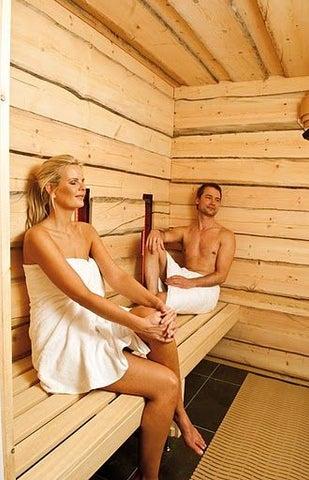Traditional Sauna Fundamentals Explained
Traditional Sauna Fundamentals Explained
Blog Article
What Does Traditional Sauna Mean?
Table of ContentsThe Only Guide for Traditional SaunaRumored Buzz on Traditional SaunaThe Buzz on Traditional SaunaThe Single Strategy To Use For Traditional Sauna
A lot of the weight lost in a sauna is water loss and is re-gained upon rehydrating. Nevertheless, undoubtedly sauna can be an integral part of a healthy weight-loss program. To look at the distinctions between conventional and IR saunas, I will separate these right into proven, theoretical, and fabricated distinctions.Therefore, the best point in the saunawhich goes to the ceiling straight above the sauna heateris commonly between 185 and 190 F. Traditional Sauna. Claims that a typical sauna goes beyond 200 F is merely not real and not relevant for electrical saunas marketed in the United States. The temperature for a far-infrared sauna is typically set in between 120 and 140 F; however, unlike the traditional sauna, the goal in and IR room is not to attain a high temperature level
As a result of this, the temperature difference is nearly irrelevant, considering that extreme sweating causes both sauna types, yet the technique of heating up the body is different. In an IR sauna the bather will certainly feel warm and will certainly sweat a lot, however at a lot lower temperature levels. Therefore, if the goal is to invest longer periods of time in the sauna, the IR sauna is an excellent choice.

The 4-Minute Rule for Traditional Sauna
When the high temperature level is achieved, the elements cycle on and off to maintain the heat. A lot of traditional sauna individuals appreciate pouring water over the rocks to produce heavy steam to increase sauna humidity degrees. The advantages of putting water over the rocks consist of: making the area extra comfy, moistening the nasal passages, and permitting the usage of aromatherapy by blending important oils with the water.
In a far-infrared sauna, the warm waves pass through the body to effectively heat the body and increase the body core temperature level. To accomplish this boosted temperature level, Far-infrared emitters produce infrared energy which is close to the same wavelength as that which the body normally emitsoften described as the "Important Range" of 7 to 14 microns), their website so the energy is well gotten by the body.
When the energy enters the body, it causes the body temperature to boost and ultimately results in perspiration. In an infrared sauna it's important for the emitters/heaters to remain on nearly frequently. Since there is no mass of rocks to retain warmth, the sauna will certainly cool if the emitters turned off.
As pointed out above, the sauna bather in an infrared area desires to place himself in front of running emitters to get maximum take advantage of the warmth. The home heating time for both areas can be really different, depending upon exactly how the spaces are utilized. For a standard sauna, a bather must allow 30-40 minutes for the room to achieve a wanted temperature level and to appropriately pre-heat the rocks.
Rumored Buzz on Traditional Sauna
A well created sauna will normally attain a temperature of 150-160 F in regarding 30-40 mins (Traditional Sauna). For hotter temperatures, the space may need to warmth for a longer duration. Once the room attains set temperature, the heating system will cycle on and off, generally running concerning 50% of the time. The shielded walls and the warmed rocks will certainly maintain the room warm and at stable temperature levels.
To some, 15 minutes was "wasted" while the infrared energy heated up the timber panels instead of heating up a body, while others find a pre-heated space to be extra comfy and believe an elevated beginning temperature level is essential to begin sweating. The length of recommended use for each area is around the very same (10-15 mins per session); however, due to the lower air temperature levels and the capability to really feel the impacts of infrared warm quicker than a typical sauna, it is not uncommon for a person to invest a total amount of 20-30 minutes in an Read More Here infrared sauna.
Typical saunas have a tendency to be larger (hence utilize more power) than infrared saunas, although typical saunas are definitely readily available in one and 2 individual sizes also. For a two-person traditional sauna, 5x6 or 5x7 size is most popular. The top bench can easily seat two or 3 individuals and is likewise enough time to relax throughout the sauna session.


The ordinary cost per kWH of power in the united state is around $0.11, so a 4.5 kW heater will certainly cost around $.50 to run for one hour, if the heater runs continually for one hour. Generally a sauna heating system will compete 75% of the very first hour and 50% of succeeding hours on because the elements cycle once the set temperature is attained.
The 6-Minute Rule for Traditional Sauna
A two individual far-infrared area is normally literally smaller sized than a typical sauna, usually about 4' x 4' or smaller. The more IR furnace is commonly 1.5-1.7 kW using a 120 volt 15 amp plug-in solution. Because the space can be used sooner than a sauna space, we will certainly think the space is used for to of an hour including warm up time.
Lastly, there is a rarely reviewed distinction in the social experience between the two rooms. While our society has actually lost a few of the social benefit of the conventional sauna experience, it can be extremely socially fulfilling. From family members time in the sauna, to heart-felt discussions with loved ones, to sauna partiesthe typical sauna experience can bring about intimate mingling.
A lot of higher end infrared areas include tinted light treatment, audio systems and full-glass fronts.
Report this page